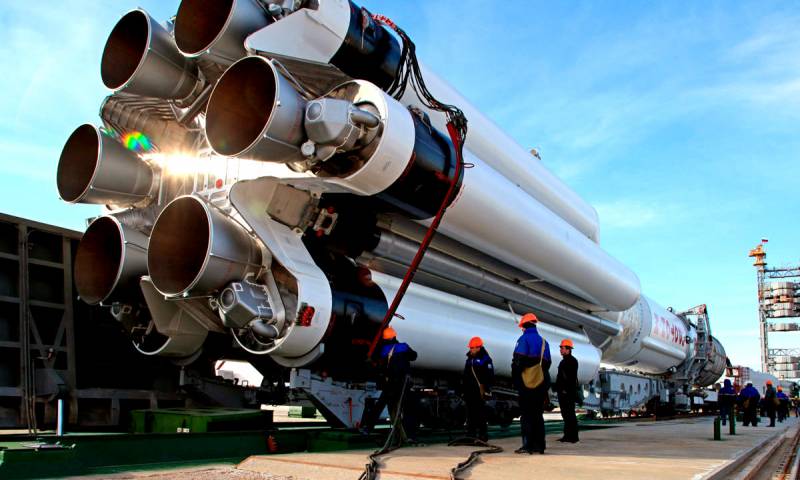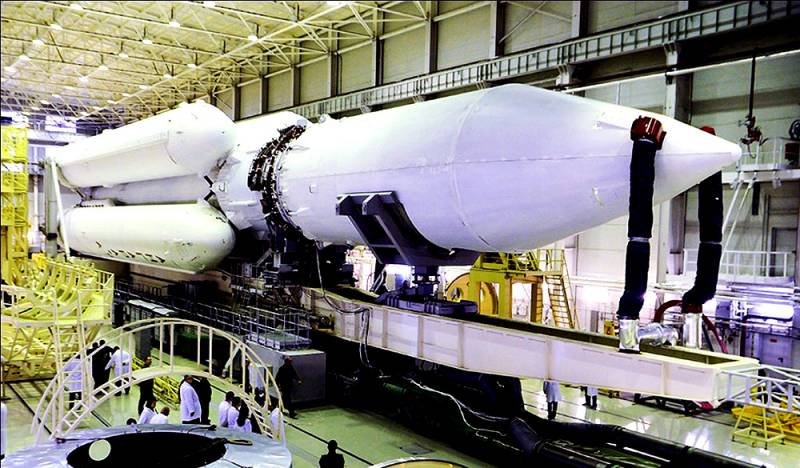Time-tested rocket taken away from Russian space
A whole era in the history of Russian space is ending. Dmitry Rogozin set the state-owned corporation Roscosmos the task of discontinuing the legendary Proton launch vehicle:
Proton has earned well-deserved recognition and respect throughout the world. The carrier rocket began to be developed in the sixties, the first had two launch stages, Proton-K has already become a three-stage. To date, the main workhorse of Roscosmos is the modern modification of the rocket under the Proton-M index. Experts note that the creation of the Mir orbital station, the International Space Station and the sending of Russian lunar rovers to the Earth’s satellite, we owe to Proton. These launch vehicles launched a huge number of military, scientific and civil spacecraft into orbit.
However, the honored space worker has long had time for a well-deserved rest.
At first, historically, the launch of "Protons" is possible only from Baikonur. As a fuel, the old launch vehicle uses heptyl, known for its high toxicity. Since launch vehicles are disposable, they fall on the territory of Kazakhstan. After each launch, cleaning of the surrounding area is required, which is very expensive. Astana demands to stop using the Proton, which is dangerous for the environment, as soon as possible. The competitive advantage of Angara is its environmental safety, as its engines are reliable and run on kerosene. In addition, the Angara can be used from cosmodromes in Russia, relieving it of its dependence on other states.
Secondly, a number of components used in the production of "Protons" have to be imported from abroad, which is fraught with Western sanctions. Angara was originally created as a purely internal project, and all enterprises of its production cycle are located in Russia.
Thirdly, replacing the "Angara" was developed as a modular project for all classes of carrying capacity, up to super heavy. Therefore, in the long term, the profitability of Angara launches will be higher than that of the aged Protons.
Angara began to be developed in 1995. She first started with Plesetsk in 2014. From a single launcher, missiles can be launched from the lightest to the heaviest classes, which is extremely beneficial economically. Serial production will be established in Omsk, at least five missiles are expected per year.
Experts reassure that the strategic transition to the Angara does not mean an immediate abandonment of the Protons. Their launches will continue as part of the Federal Space Program, as well as to fulfill foreign orders. In addition, experts note that, unlike the reliable "Proton" with a huge history of successful operation, the "Angara" flew only a few times, so it will take time to build a good reputation.
Project close. Fly on the "Hangar"
Proton has earned well-deserved recognition and respect throughout the world. The carrier rocket began to be developed in the sixties, the first had two launch stages, Proton-K has already become a three-stage. To date, the main workhorse of Roscosmos is the modern modification of the rocket under the Proton-M index. Experts note that the creation of the Mir orbital station, the International Space Station and the sending of Russian lunar rovers to the Earth’s satellite, we owe to Proton. These launch vehicles launched a huge number of military, scientific and civil spacecraft into orbit.
However, the honored space worker has long had time for a well-deserved rest.
At first, historically, the launch of "Protons" is possible only from Baikonur. As a fuel, the old launch vehicle uses heptyl, known for its high toxicity. Since launch vehicles are disposable, they fall on the territory of Kazakhstan. After each launch, cleaning of the surrounding area is required, which is very expensive. Astana demands to stop using the Proton, which is dangerous for the environment, as soon as possible. The competitive advantage of Angara is its environmental safety, as its engines are reliable and run on kerosene. In addition, the Angara can be used from cosmodromes in Russia, relieving it of its dependence on other states.
Secondly, a number of components used in the production of "Protons" have to be imported from abroad, which is fraught with Western sanctions. Angara was originally created as a purely internal project, and all enterprises of its production cycle are located in Russia.
Thirdly, replacing the "Angara" was developed as a modular project for all classes of carrying capacity, up to super heavy. Therefore, in the long term, the profitability of Angara launches will be higher than that of the aged Protons.
Angara began to be developed in 1995. She first started with Plesetsk in 2014. From a single launcher, missiles can be launched from the lightest to the heaviest classes, which is extremely beneficial economically. Serial production will be established in Omsk, at least five missiles are expected per year.
Experts reassure that the strategic transition to the Angara does not mean an immediate abandonment of the Protons. Their launches will continue as part of the Federal Space Program, as well as to fulfill foreign orders. In addition, experts note that, unlike the reliable "Proton" with a huge history of successful operation, the "Angara" flew only a few times, so it will take time to build a good reputation.
- Sergey Marzhetsky
- https://mir24.tv/


Information